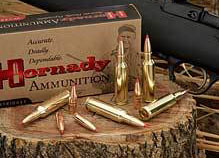|
Hornady GMX Bullets and Ammunition By Chuck Hawks  For the Spring of 2009, Hornady announced the introduction of GMX bullets and factory loaded ammunition using these bullets. "GMX" stands for "Gilding Metal eXpanding." The GMX is initially available in the following calibers and weights: .270/130 grain, 7mm/139 grain, .30/150 grain, .30/165 grain and .338/225 grain. The GMX is a monolithic bullet along the lines of the Barnes Tipped TSX bullet, but with a red (rather than blue) plastic tip to initiate expansion. These are very sleek, boat-tail bullets with high ballistic coefficients, similar in shape to the popular Hornady SST bullets. Like all such monolithic bullets, they are longer for their caliber and weight than conventional lead core, jacketed bullets and intrude deeper into the cartridge case when seated for the same cartridge overall length. Unlike the 100% copper Barnes TSX bullet, Hornady's GMX is made from gilding metal, a 95% copper + 5% zinc alloy devised long ago to reduce copper fouling in gun barrels. Gilding metal is slightly harder than pure copper and superior to copper for bullet jackets. Whether it will prove superior for homogenous bullets remains to be seen, but I expect that it will. It should leave less bore fouling than pure copper bullets and Nosler/Winchester (Combined Technology) has also introduced a tipped gilding metal bullet (E-Tip). Note that the Hornady GMX bullets illustrated have only two shallow fouling grooves, rather than the four deeper grooves present in Barnes TSX bullets. Presumably, this is because there is less bullet fouling to deal with due to the Hornady bullet's gilding metal construction. Hornady claims the following advantages for GMX bullets:
Here is what Hornady says about their new GMX bullets: "The new Hornady GMX� (Gilding Metal eXpanding) bullets and factory ammunition offer the hunter who favors an expanding monolithic bullet a better choice. GMX bullets are constructed of the same gilding metal used to make ultra-consistent Hornady bullet jackets. Gilding metal doesn�t foul like �sticky� solid copper and strategically located grooves in the bearing surface of the bullet reduce pressure. These additions make the GMX easy to load using standard published data for comparable Hornady SST� bullets." "Hornady engineers designed the GMX bullet to perform across a very wide range of velocities, from +3,400 to 2,000 fps, and perform it does. GMX bullets are designed to expand to 1.5 times their original diameter and retain over 95% of their original weight. They�re no slouch in the penetration department either, routinely penetrating over 30" in gelatin tests."  Left to right: cut-away, unfired, 3400 fps, 2700 fps, 2000 fps. Illustration courtesy of Hornady Manufacturing. The plastic tip of the Hornady GMX helps to initiate expansion and conceals a larger hollow point cavity than used in the seminal Barnes TSX bullet. Even so, Barnes claims that TSX bullet expansion initiates at impact velocities as low as 1600 fps, while Hornady admits that GMX bullets require at least 2000 fps at impact, presumably because gilding metal is harder than pure copper. I would conclude that Hornady GMX bullets are most applicable to cartridges that can launch them at muzzle velocities (MV) exceeding 3000 fps. For example, the photo above shows that the .30 caliber, 150 grain GMX achieves adequate expansion at an impact velocity of 2700 fps. That is the MV of typical .308 Winchester and .300 Savage loads fired from many hunting rifles! In other words, when launched at 2700 fps, at 300 yards this bullet can be expected to NOT expand adequately. Fired at a MV of 3200 fps, as from a .300 Magnum, the 150 grain GMX should be traveling at 2735 fps at 200 yards, at which distance it should expand effectively. Fired from most standard cartridges, and particularly for use on CXP2 game, conventional (lead core) Hornady Spire Point Interlock or SST Interlock bullets should give quicker, more humane kills than GMX bullets. GMX bullets are probably most appropriate when extreme penetration is required and/or very high muzzle velocities pertain. I have never been a fan of monolithic, pure copper bullets due to their propensity to foul the bore and because they require special barrel cleaning procedures. I look forward to testing some Hornady GMX gilding metal bullets soon in the hope that they make these problems a thing of the past. |